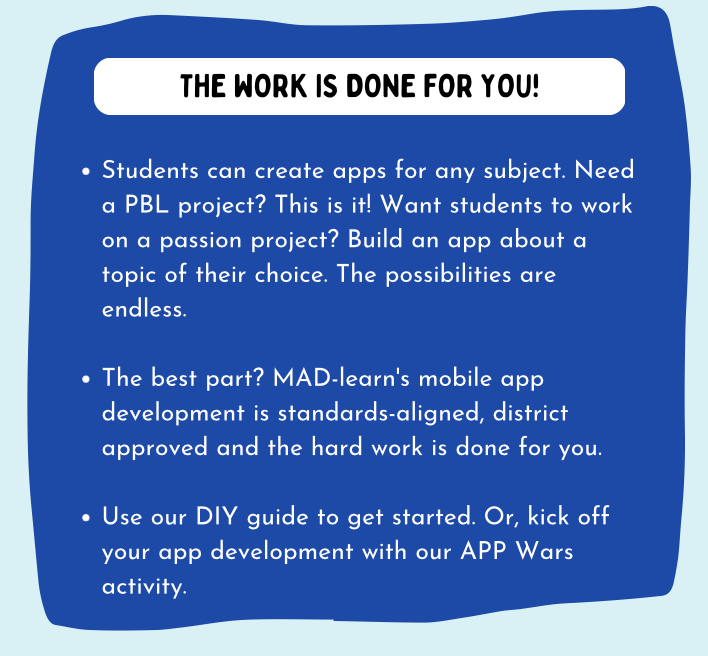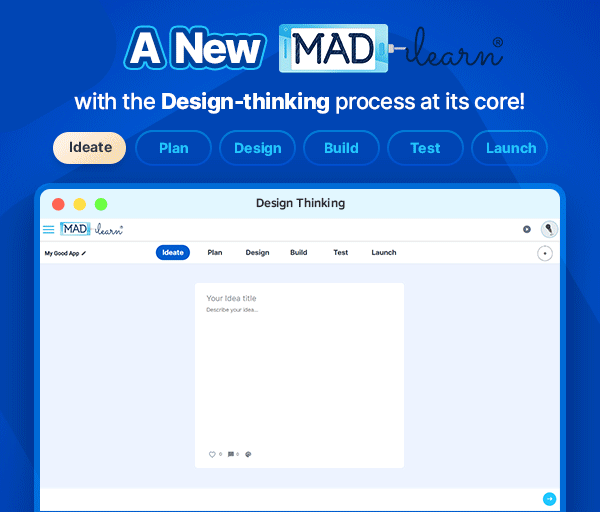Students are faced with challenges far greater than their adult counterparts have ever known. Often interrelated factors such as the pandemic, teacher flight, changing family dynamics, a rise in social issues, and more have made it increasingly difficult to keep students focused and motivated. How can these threats to our children’s livelihood be addressed and overcome? What common thread could be instituted to work across the curricula and school community to re-establish the importance of education and love of learning?
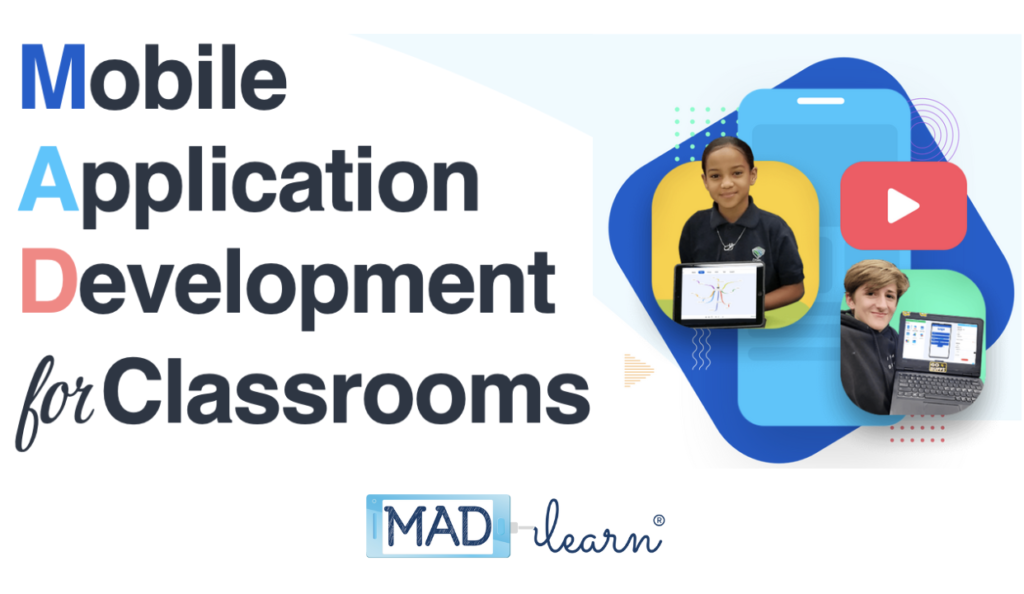
Vital and Transferable Skills
The key may well be the introduction and development of projects that incorporate relatable, relevant outcomes to the development of skills students need to succeed, not just in school, but beyond. We at MAD-learn refer to such skills as “vital and transferable”. Our work with schools throughout the country and globally has yielded such successes for well over nine years. A shift in the paradigm from students being mere users of mobile technologies to creators of it has impacted their progress in both STEM-related subjects and core disciplines such as math, science, English, and social studies. This has been realized by relating just about any subject matter (whether academic or social) and having students create a mobile app to share information about their topic in a relatable manner. The curriculum is based on the Design Thinking Process. This encourages a higher level of quality in the end product (while focusing on process), and provides students with tools to create better products in other classes. As noted by The International Review of Research in Open and Distributive Learning, “the educational value of mobile app design activities, and the possibility and practicality of teaching/learning mobile app design online, which can further encourage educators to explore and experiment on the potential of incorporating these learning activities in their diverse settings.”1

A study conducted by the New Zealand Ministry of Education concluded the following:
“When students make apps, they learn:
- valuable STEAM skills like coding, programming, graphic design, and content creation
- how to solve real-world problems with digital design.
Whether tackling challenges at school, within the community, or even on a global scale – knowing how to build apps empowers students to meaningfully change their environment through technological intervention.”
“Using app development as a context for learning in your classroom, you can explore the technological areas – in particular:
- digital technologies
- computational thinking for digital technologies
- designing and developing digital outcomes
- design and visual communication
Think about how developing an app can be integrated across different curriculum learning areas and support students’ digital literacy.”2
Project and Problem-Based Learning
One key is the strong link between mobile app development and Project Based Learning. This strategy has proven extremely successful, and mobile app development is a natural option. One researcher noted, “High-Quality Project Based Learning can be transformative for students. By presenting students with a complex mix of choice and responsibility, cognitive concepts, and practical activities, within a collaborative educational environment of real-world authenticity, high-quality projects engage students in learning that is deep and long-lasting. Such projects also build success skills that prepare students for the adult world and the workplace and create confident young people who are willing and ready to take on challenges. We believe there is research evidence – and there definitely is educational theory – that argues strongly for the use of Project Based Learning with all students.”3
Another case study detailed the advantages of having mobile app development as a PBL cornerstone. This paper described “how the material was structured and how the mobile app development was performed from the design phase through the beta-version app as tested on mobile devices. We explored several mobile applications developed on both Apple and Android platforms as sample case studies. In the case studies, we highlighted the quality of the design (the graphical user interface) depending on the student’s interest.” The study also “emphasized the importance of the students’ role for an end product’s success. The goals, methodology, logistics, lessons learned, and instructors’ observations of the experience…”4
PBL environments can foster endless opportunities for students to develop critical thinking skills, important in all subjects. An article in the Journal of Studies in Education noted, “Because the development of critical thinking skills may be correlated to learning styles, teachers should continue to study techniques and methods to engage all students in these cognitive processes. Problem solving and critical thinking competencies are highly valued by employers in any profession.” The paper added, “These competencies are widely recognized by all disciplines within the university as a central component of general education. The research points to a needed transformation of the classroom from a passive learning forum to a learning environment that focuses not only on content, but also on the goal of equipping students with lifelong cognitive skills. These skills are required for future success and are promoted in a classroom that centers student learning on problem solving, not solutions.”5
The MAD-learn program makes a wide range of talents valuable to a given project. Vicky Davis, a respected technology integrator and author, had firsthand experience with MAD-learn beginning in 2017. In an article for Edutopia, she reported the following:
“In addition to all the marketing, graphic design, website building, and content creation activities that
take place when you create an app, the students are learning brainstorming and social entrepreneurship.
They’re also learning how to collaborate with other students around the world. And that’s perhaps the most challenging aspect of what we do. It can be difficult for people to work with someone who is in the same room, so learning how to collaborate with students around the world can be quite challenging. My students have done this for the past 10 years, making videos and wikis and websites. But making an app brings collaboration to a whole new level because students have to write the app, build the website and social media presence for it, and present it collaboratively to the online sharks who evaluate apps. In some ways, these students have created their own mini-companies in an eight-week project that I hesitate to even call a project.
Creating apps is not a project—it’s project-based learning at its best. It meets every single ISTE NETS standard for students. And the students learn individual skills—some are graphic designers, some are writers and editors and marketers, and others are project managers and leaders—but they also learn to work together as a team.”6
Dr. Davis adds, “And the project can be life-changing. When our salutatorian—one of our app project managers—gave his speech at graduation, he thanked me for his time as a 10th grader presenting his app. That real-world introduction to speechmaking was why he felt ready to make his speech as a graduating senior. It’s rare that students name a specific project as formative, but my students frequently name app building as something that changed their world… I’ve learned that class is often not in a textbook or a test. It doesn’t come in little tidy lesson plans. It arrives in a comprehensive, large, collaborative, rigorous, exciting, global programming project that has changed the lives of my students.”6
Mobile app development as a component of Problem-Based Learning can have several benefits, as well. It can provide students with an opportunity to develop practical skills that they can apply in their future careers. By working on real-world problems, students can learn how to design and develop mobile applications that meet the needs of users. :ile Project Based Learning, this approach helps students develop critical thinking skills. They learn how to analyze problems, identify the root cause, and develop solutions that are effective and efficient. Collaboration and teamwork are two more important byproducts. In mobile app development, teamwork is essential as it involves multiple stakeholders, including designers, developers, and project managers.
We have seen classes in which various techniques have been executed successfully. For example, students may work on a specific task, such as designing a mobile app for a non-profit organization. The students work in groups and collaborate to develop a solution that meets the needs of the organization. These students gain access to authentic data and resources to help them develop their solutions.
Making Programming and Coding Accessible
A UK study also made a case for making the introduction to programming more accessible by moving away from more “traditional” approaches:
“The focused and linear approach of teaching each student the complexities and vocabulary of the language’s syntax does not often promote creativity and inquiry-based learning. Due to the extensive amount of syntax required to create a computer program, students are left to memorize and accept traditional programming concepts without investment or engagement in the topics. As a result, students often do not recognize or appreciate the problem-solving opportunities within the software development process; students then become disengaged and thus tend to move towards other areas of study, causing a depletion of brain power and incoming fresh talent into the CS industry.”7

MAD-learn’s strength is due in large part to its ability to “meet students where they are” in terms of familiarity with programming and coding. Apps can be built using no code, adaptive code, or student-generated code. In this exhaustive study, “Pre and post-quiz analysis showed a significant improvement in students’ ability to design comprehensive solutions to a given problem. Survey results also showed increased student engagement, high interest in computing, and a ‘better’ understanding of information technology.”7
MAD-learn is an easy-to-implement, design-thinking-based program. The nurturing of critical thinking skills is only one of the benefits of an app development program based in this process. Similar observations have been made by others focused on this realm:
“The growth in the tech industry in recent years has increased business major students’ interest in software programming and app development. However, the traditional way of teaching these courses involves intensive coding exercises and little interaction among students. These methods often discourage the students due to the slow learning curve and limit instructors’ options to engage the students in class. To address these problems, we designed a teaching protocol for integrating Design Thinking into a Mobile App Development course. Our protocol offers a step-by-step implementation guide and instances from a real-life examination at a California State University. The proposed guideline can be extended and applied to other courses and curricula in the business information systems domain.”8
Career Potential
The above paper goes on to relate the observations above to career opportunities in the future, revealing, “The tremendous growth in the mobile app industry and app usage in recent years has made app development one of the most in-demand skills in the U.S.,” adding, “among their customers. These findings are in line with the rapid expansion of mobile apps in the consumer market. Companies like Apple, Google, and Amazon are reporting record numbers of app downloads. For example, the number of apps available through the Apple App Store has grown exponentially in less than 12 years, from only 500 apps in 2008 to more than 2.2 million apps in 2020. The “iOS app economy” has created 4.5 million jobs globally and brought in $189 billion to iOS app developers.”8
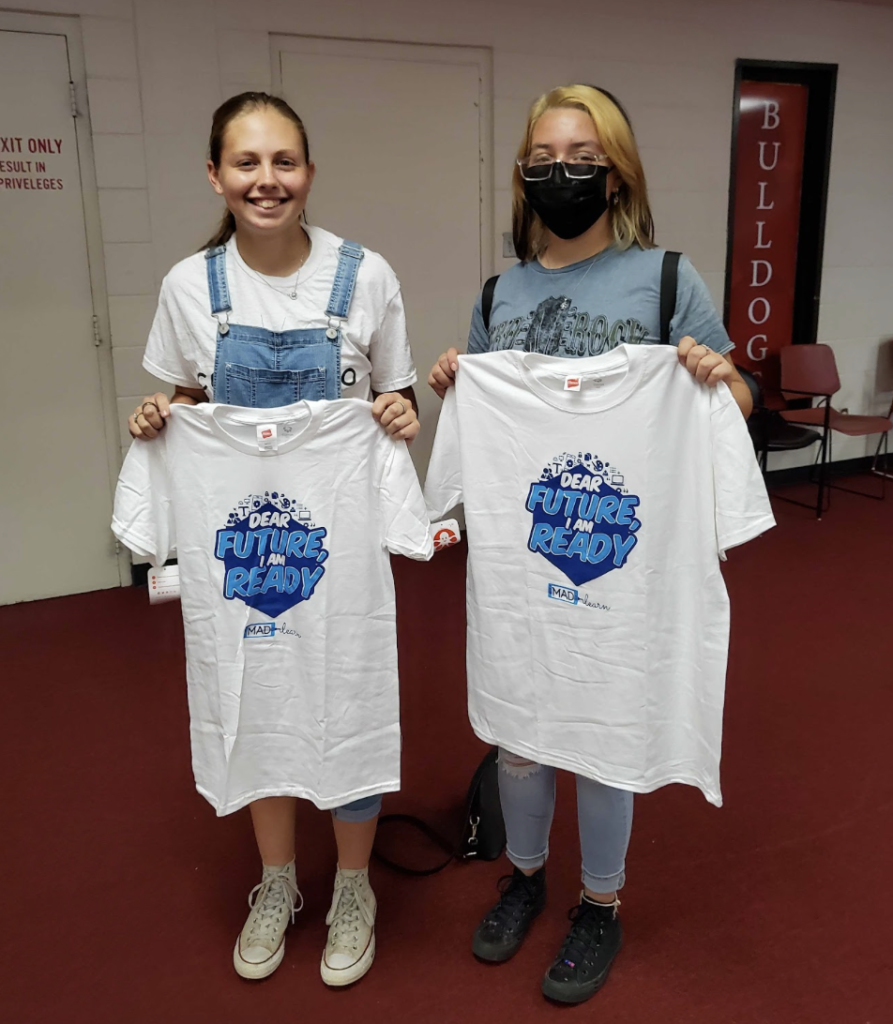
An article from computerscience.org further stated, “According to data.ai’s ‘State of Mobile in 2022’ report, users downloaded more than 230 billion mobile apps in 2022, up 5% year over year. The U.S. Bureau of Labor Statistics projects 22% job growth for software development professionals from 2020-2030. This sector boasts a median salary of $110,140 as of 2020.”9
While MAD-learn is aligned with all major STEM organizations (ISTE, CSTA, and state standards for New York, Florida, Texas, Georgia, and more), it also aligns with CTE standards. These skills, which may be taught through the education and workforce development systems, fall into three broad categories:
• Effective Relationships—The interpersonal skills and personal qualities that enable individuals to
interact effectively with clients, coworkers, and supervisors
• Workplace Skills—The analytical and organizational skills and understandings that employees need
to successfully perform work tasks
• Applied Knowledge—The thoughtful integration of academic knowledge and technical skills, put to
practical use in the workplace10
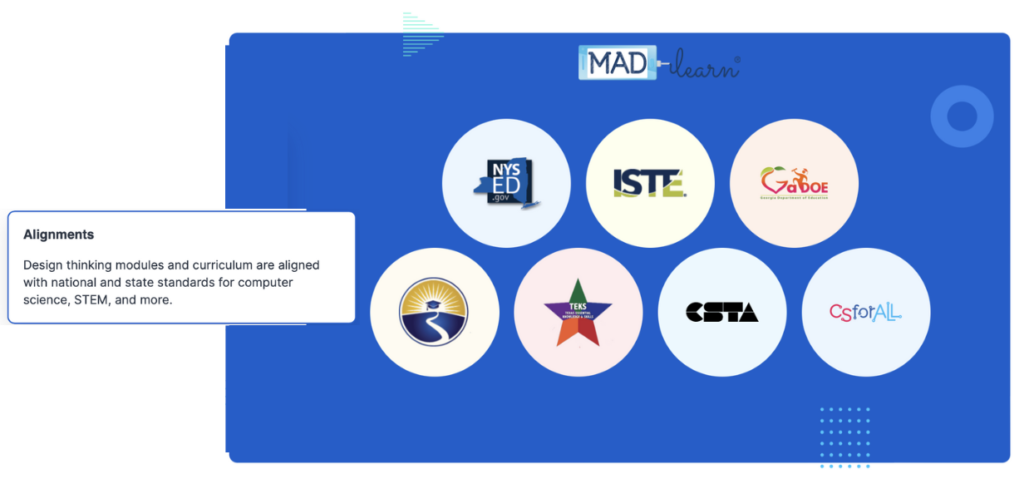
Coding and Math
There is sound evidence of coding’s relationship to the development of enhanced math skills. One example is a MINDResearch.org article entitled “How Coding Supports the Mathematical Practices”. It outlines the following connections:
• Coding Builds Problem-Solving Skills and Persistence
“Creative problem-solving skills are not only important for future jobs in the technology space, but others as well. In a survey from Adobe, 85% of educators and 84% of policymakers agreed that problem-solving skills are in high demand today for senior-level/higher-paying careers.
What can help students build persistence in problem-solving? Students who are actively engaged are intrinsically motivated to persist through challenges.”
• Coding Promotes Abstract Reasoning
“One of the common abstract ideas in both algebra and coding is the concept of variables.”
• Coding Models Mathematics
“The third mathematical practice is to model with mathematics. According to the standard, students “are able to identify important quantities in a practical situation and map their relationships using such tools as diagrams, two-way tables, graphs, flowcharts, and formulas.”
Sometimes, however, there’s too much data to write out in tables and put into graphs and formulas by hand. That’s where coding can be used as a tool to create better mathematical models.
Not only can students build or use tools to solve problems, but they can also create tools to help others. When students create an application or digital game they are actively using their skills in mathematics to create something that others can use.”
• Coding Builds Attention to Precision
“Like the visual instructional program ST Math, the informative feedback of code shows students their solution and how it did or didn’t work. Even a lack of feedback shows that something didn’t go as imagined. In the feedback is the information on how to improve on the solution. Neuroscientists call this process of hypothesizing, acting, observing, and adjusting the action the perception-action cycle.”11
A blog from skoolofcode.org provides further observations in this regard:
“Children learn several concepts in their math and science classes. Coding provides them with a space to apply these concepts. It also improves their understanding of these concepts. It also strengthens their recall power. Children also learn several different ways to apply a concept. This in turn improves their math performance.”
“Coding encourages children to think out of the box. It pushes them to visualize well-defined steps, look out for similarities and differences. It shapes their thought process in a more refined way.”
“Key Takeaways:
- Children use several skills like pattern identification, analytical skills, and critical thinking. While coding they tend to pay attention to detail. Coding is the practical application of math. It helps improve the mean problem-solving skills in children.
- Coding helps improve a child’s logical reasoning skills. It is by improving their perceptual and communication skills in a practical environment.
- It also helps in enhancing a child’s memory by activating certain brain regions. It also improves working memory because of its spontaneity. The process of learning programming dialects improves memory.
- Coding makes math more fun and creative. It is because of the real-life examples children can relate to. It is a very active process while math in classrooms can be very passive in nature.”12
Social Development
Finally, being a student is but one part of a child’s life. Beyond the academic needs lie positive social and emotional growth. MAD-learn encourages students to build apps that are socially relevant. The program also helps promote social skill development within the process itself. As some experts have noted, social skill development is something that cannot be overlooked. A paper entitled “App Development for the Social Good: Teaching a Socially Conscious Mobile App Development in an Upper-Level Computer Science Course” detailed this and included several cross references. In part, it stated the following:
“In recent years, there are a number of institutions that offer courses on mobile technology, which can be classified into three categories. First, mobile application development classes, in which students learn about building applications. Second, mobile computing classes, in which students study mobile computing-related issues and algorithms. Third, mobile computing client classes, in which students learn traditional CS concepts using mobile development as a context for examples. However, there is hardly any course that teaches ethical practices from the context of mobile application development integrating socially conscious computing. One of the very few relevant research works reported their experiences in implementing support for autonomy (consent and withdrawal) and minimizing privacy risks in a research app deployed via the Apple App Store. The authors argued that while it is possible and desirable to implement a research app according to ethical guidelines and frameworks, the uncertainties require ongoing attention to ethical issues during development as well as post-deployment. Another relevant work is presented in, where Wart et al. developed a twelve-week “Apps for Social Justice course” that was taught at an after-school program and students were exposed to classic social justice literature, identified local community needs, and went through a design process to create fully functional mobile applications to address those needs. As an example of standalone courses, Sung et al. offered two upper-year mobile computing electives, with one focused on the implementation of a mobile application and the other on the design of mobile applications. Many other institutions have applied or used mobile technologies to enhance their teaching and students’ learning experiences. Cobcroft et al. studied mobile learning outcomes, challenges, and proposed guidelines for future mobile learning experiences. Fenwick et al. describe upper-level courses that center on Android development.”13
The research showed that “students were very excited by having to apply what they learned to complex ethical situations during their project. Each team focused on developing a mobile application that can be used for the purpose of “social good”. The instructors’ experiences, students’ grades, course evaluations, anecdotal
evidence, and students’ feedback indicate that the integration of socially conscious computing in a mobile development course helped to provide (mostly) positive learning experience to students.”13
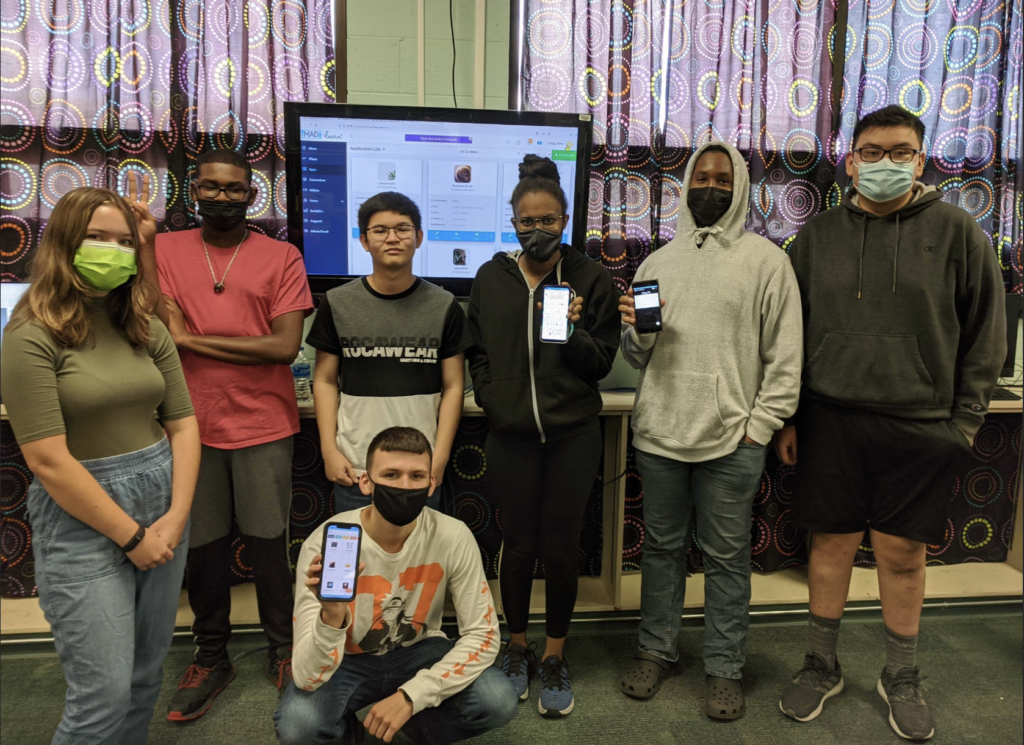
Summary
The justification for making a design-thinking-based, relevant, and engaging program like MAD-learn as a mobile app development program is clear. It is, at its core, a project-based learning experience that imparts vital and transferable skills to today’s uniquely challenged students. It directly addresses the expectations of both STEM and CTE directives in an accessible approach to learning about how to build technology. There are obvious connections between app development and improved skills in mathematics. The process and product delivery are rooted in social skills development. Lastly, it focuses on the future and the potential for success far beyond the day when students receive their caps and gowns.
Sources Cited:
- The International Review of Research in Open and Distributive Learning “Mobile App Design for Teaching and Learning: Educators’ Experiences in an Online Graduate Course”
https://www.irrodl.org/index.php/irrodl/article/view/1542/2635
- New Zealand Ministry of Education “App development in the classroom”
https://elearning.tki.org.nz/Teaching/Future-focused-learning/App-development
- High Quality Project Based Learning “Defining High Quality PBL: A Look at the Research”
https://hqpbl.org/wp-content/uploads/2018/04/Defining-High-Quality-PBL-A-Look-at-the-Research-.pdf
- SITE 2018 “A Methodology of Teaching Mobile Development for Undergraduate Students
in Project-Based Classes”
https://www.researchgate.net/publication/324840699_A_Methodology_of_Teaching_Mobile_
Development_for_Undergraduate_Students_in_Project-Based_Classes
- Journal of Studies in Education “Engaging Students in Critical Thinking and Problem Solving: A Brief Review of the Literature”
https://www.macrothink.org/journal/index.php/jse/article/viewFile/8249/6802
- Edutopia “The Impact of Student-Created Apps: Building apps teaches teens far more than just computer skills—they also learn social entrepreneurship and gain self-confidence.”
https://www.edutopia.org/article/impact-student-created-apps
- Journal of Information Systems Education “Mobile App Development to Increase Student Engagement and Problem-Solving Skills”
https://core.ac.uk/download/pdf/301384564.pdf
- Journal of Information Systems Education “Design Thinking and Mobil App Development: A Teaching Protocol”
https://www.proquest.com/openview/f87558aba351eb97ad07bc4a3a99faed/1?pq-origsite=gscholar&cbl=25848
- computerscience.org “How to Learn App Development”
- American Institutes for Research “Integrating Employability Skills: A Framework for All Educators”
https://ccrscenter.org/sites/default/files/EmployabilitySkills_Handouts.pdf
- MINDResearch “How Coding Supports the Mathematical Practices”
https://blog.mindresearch.org/blog/coding-mathematical-practices
- SKOOL of Code “How Coding Helps in Improving Kids’ Math Performance”
- ASEE Annual Conference Paper Presentation “App Development for the Social Good: Teaching a Socially Conscious Mobile App Development in an Upper-Level Computer Science Course”

